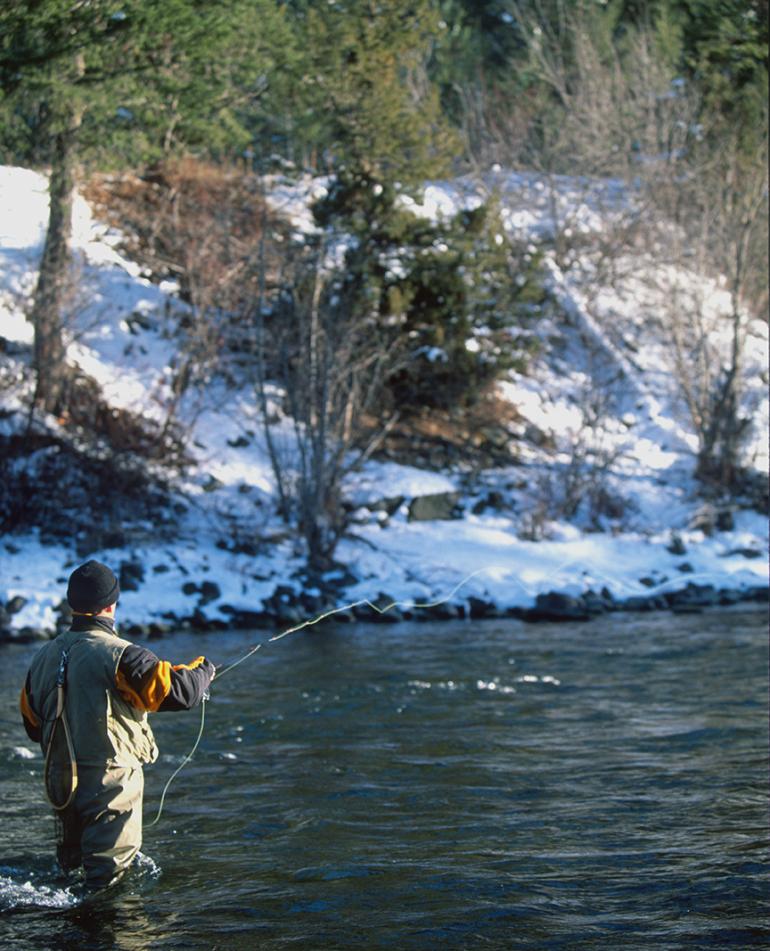Stretching the Season
Winter fishing tips & tricks.
As the days grow shorter and snow covers the valley floor, thoughts of fly fishing dwindle in almost every angler’s mind. However, rivers that see a plethora of fishermen throughout the warmer months are now open to unique opportunities for solitude. The absence of other anglers on the water does not mean that the fishing is not “good” during this time of year, but it can be challenging. Winter fly fishing is often emotionally taxing, too, because the weather and the temperatures can be tough to overcome. Here’s what you can do to add another fishing season to the calendar.
Dress for Success
Although ten below can feel extremely chilly when wading waist-deep in a local streambed, temperatures often reach the 30s and 40s on many winter afternoons. That can be very conducive to angling as long as your clothing is layered and comfortable. Long johns and wool socks are always a good bet under sweatpants and waders. Good wading boots are crucial this time of year because you are more likely to fall. Hypothermia is a serious concern, and a wet body can suffer from this condition extremely quickly.
Sleep In & Know What to Fish
In winter, the fish become considerably more lethargic. They begin to feed during the warmer times of day, so getting to the river in the cold morning hours is usually not necessary.
Stoneflies are always a good option as a winter lead fly. These insects live in the streambed year-round, and for the unlucky ones that become dislodged from their hidey-holes beneath the rocks, they are usually met by a set of hungry teeth from their predatory counterparts.
Dead-drifting smaller streamer patterns followed by an egg or a worm can produce the biggest fish of the season. Midges are also a huge portion of a trout’s diet. These insects hatch on warmer winter afternoons and can provide some of the most intense action of the day.
Hiking over a shallow flat and stalking these surface-feeding trout can be a humbling yet enriching experience. When wading through the flats, trout that are hidden in the summer by higher flows are visible and will produce a “trout fever” effect that can make for bad casts and poor judgment. Still, a trout landed on a size-20 midge dry tied to 6x tippet can be an extremely rewarding moment in any angler’s day.
Places to Go
Gallatin: Only 20 minutes from downtown Bozeman, the Gallatin fishes extremely well in any month of winter. The midge hatches can become epic, allowing a good two to four hours of solid fishing on any given day. However, be wary of the shelf ice present throughout many of the winter months. Although much of it is thick enough to walk on, some is thinner than it looks; be careful.
Lower Madison: The midge hatches on this river can provide some of the most spectacular dry-fly fishing of the season. A Griffith’s gnat drifted over a sipping trout can make the most seasoned of dry-fly anglers get all giddy and euphoric.
East Gallatin: If it is free from ice shelves, this river can demonstrate to any angler what it truly means to become schooled. Light tippet and small flies enable the large fish present throughout the river’s entirety to “put on a show.”
There is an old joke that you’re supposed to fish as many days per year as you are old. But if this is true, most people around here are under 50. Winter fishing in this state is a fun activity, and even the most determined skier or snowboarder can find the time to enjoy the solitude that many of these rivers provide. This winter, grab a rod, pack a thermos of hot chocolate, and get out there.











